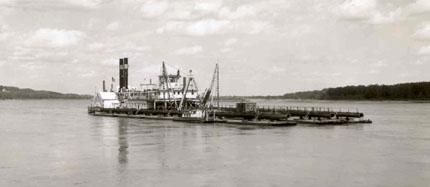The Corps of Engineers Named Vessels to Honor Members of the Lewis and Clark Expedition
The Lewis and Clark Expedition’s main corridor westward—from Camp River Dubois on the Mississippi, 14 May 1804, and for the return journey in 1806—was the Missouri River. In 1824 Congress passed legislation that initiated a program that eventually gave the U.S. Army Corps of Engineers responsibility for maintaining the navigability of the nation’s major inland waterways, including the Missouri and its tributaries. It was therefore fitting that the Corps districts within the Missouri River system operated seven vessels bearing the names of members of the Lewis and Clark Expedition.
In 1932 the Kansas City District took delivery of the Captain Meriwether Lewis and the William Clark. The boats named for the co-leaders of the Corps of Discovery were virtually identical steel-hulled, oil-fueled, “dustpan” dredges, used for deepening and widening the channels of the Missouri and its tributaries. Later in the 1930s the Kansas City and Omaha Districts added to their floating plant vessels honoring all four honoring all four of the Expedition’s sergeants: Charles Floyd, Patrick Gass, John Ordway, and Nathaniel Pryor.
 |
| Dredge Lewis underway with pipeline on the Missouri River, 1938 |
 |
| Dredge Clark underway with attendant plant on the Missouri River, 1938 |
The Sergeant Floyd was named for the only member of the Expedition to die on the long and arduous journey. Originally an inspection boat, the Floyd later performed as a towboat. The Sergeant Gass and Sergeant Ordway, both stern-wheel survey boats, were at first assigned to the short-lived Fort Peck District and later served the Kansas City District. The Omaha District acquired the survey boat Sergeant Pryor sometime in the mid-1930s. In addition to their inspecting, surveying, and towing duties, these vessels also were used for moving personnel and equipment and for placing buoys along the river.

Sergeant Floyd on the Missouri River, 1938
The Corps also purchased a motor launch, the Sacajawea, and put her to work for the Fort Peck District. In June 1943 an explosion did considerable damage to the little craft named for Sacajawea, the Shoshone Indian wife of Toussaint Charbonneau, who was hired as an interpreter for the Expedition. The Sacajawea was soon repaired and, like her intrepid namesake, went on to perform many years of valuable service along the Missouri.
 |
| Sergeant Floyd on tour |
So too did the other boats named for members of the Corps of Discovery. Eventually, of course, all were decommissioned and either sold off or scrapped. Two of them, however, continue to have useful public functions. In 1976, as part of the Corps of Engineers’ commemoration of the bicentennial of the nation’s independence, the Corps outfitted the Floyd as a floating exhibit and sent it on a long voyage through the inland and Gulf intracoastal waterways (pictured left). In 1983, Sioux City, Iowa, purchased the boat and turned it into a dry-docked museum for interpreting the history of the Missouri River (including the Lewis and Clark Expedition) and a Welcome Center. Similarly, the town of Brownville, Nebraska, acquired the Lewis, which houses the Museum of Missouri River History. The Floyd and the Lewis were designated National Historic Landmarks in 1989. They serve as enduring reminders of the importance of both the Corps of Discovery and the Corps of Engineers in the history of the Missouri River.
* * *
July 2003